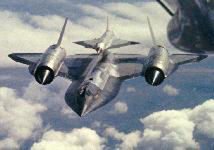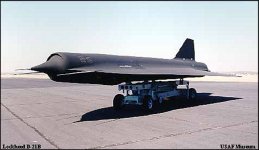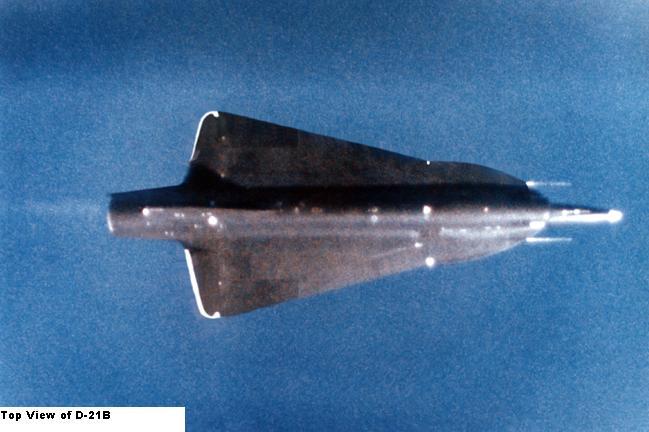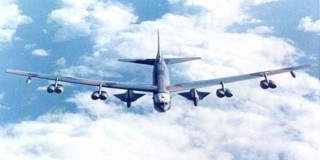


 |
 |
 |
PROJECT TAGBOARD
 |
 |
In the early 1960s, Lockheed had developed the Mach 3 "A-12" spyplane
that the CIA recognized as a possible mothership for an advanced reconnaissance
drone. A program to launch such a drone from the A-12 took precedence after
Power's U-2 was brought down in the Soviet Union. The highly secret drone was
given the preliminary designation of "Q-12.".
To limit its weight and cost, the Q-12 was designed to be expendable. Its camera
payload and guidance system were constructed in its nose section to be ejected
and recovered after a parachute descent.
The Q-12, its name changed to D-21, was carried on the back of the A-12 launch
vehicle designated as "M-21." ("M" designated
"Mother" and "D" stood for "Daughter." The project
now had the codename "Tagboard".
Built with titanium and various radar-absorbing plastic composites, the
"D-21A", looked like a stovepipe with a cone in its inlet. Its
vertical tailfin and wings running the length of the stovepipe that gave the
drone something of the look of a sweptback manta ray. Forty-two feet, 10 inches,
11,000 pounds, and having a wingspan of 19 feet, the D-21 flew up to 1,700 MPH
at a ceiling of 95,000 feet and 3,450 mile range.
A "Q-bay," contained the reconnaissance payload and guidance systems
in a module (known as a "hatch") that plugged neatly into the bay
where it could be ejected at the end of the mission to be snagged out of the air
by a C-130 Hercules similar to the method used by the Air Force to recover film
canisters from reconnaissance satellites.
The M-21 was a two-seat version of the A-12, with a pylon on the fuselage
centerline between the tailfins to carry the drone in a nose-up attitude. A
periscope allowed the back-seater, or "Launch Control Officer (LCO)",
to keep an eye on the D-21. Two M-21s were built, along with an initial batch of
seven D-21s for test flights.
The first (non-launch) flight of the M-21 and D-21 combination was on 22
December 1964 to study aerodynamics and other systems issues. The first launch
occurred on 5 March 1966. Though deemed successful, it concerned the flight crew
that the drone hovered above the back of the M-21 for several seconds.
The second successful launch took place on 27 April 1966, prompting plans to
construct 15 more D-21s. A third flight on 16 June 1966 was successful, however
a launch attempt on 30 July ended in disaster when the D-21 collided with the
M-21 on release, destroying both aircraft. The two crewmen ejected safely and
landed at sea, but one drowned when his pressure suit leaked. This accident
terminated the D-21 project as far as the A-12 (M-21) was concerned. The
Tagboard project became Senior Bowl and continued with a B-52 used as the
mothership launch vehicle. The D-21 drone was ultimately replaced by the new
KH-11 Keyhole reconnaissance satellite.
Thirty-eight D-21s were built, with 21 expended. The other 17 were put in
mothballs at the Davis-Montham Air Force Base "boneyard" near Tucson,
Arizona. Four of the drones were eventually transferred to the US National
Aeronautics & Space Administration (NASA) in the late 1990s. NASA considered
using their D-21s to test a hybrid "rocket-based combined cycle
(RBCC)" (ramjet) engine, however, this idea was abandoned, with NASA
preferring to use a derivative of the agency's X-43A hypersonic test vehicle for
the experiments. The remainder ended up in air museums.


4200TH SUPPORT SQUADRON
OFFICER ROSTER
Commander: Col Arden B. Curfman*
DCOP: LTC Edward C. Wright*
DCOT: LTC Marvin. R. Leitzel*
DCO LTC Charles E. Simpson*
Senior Bowl Pilots:
· LTC Dick Baldwin
· Maj. Robert E. Haynes
· Maj. J. W. Sayer
· Maj. John Soper
· Maj. Thomas J. Arnone
· Capt. Wayne E. Hostetler
· Capt. Robert A. Holbrook
· Capt. James A. Fain Jr.
· Capt. Robert J. Haley
B-52H Navigators:
· Maj. Archie G. Slaten
· Maj. Richard J. Hamel
· Capt. Richard F. Trowbridge
· Capt. Kenneth O. LaVergne
· Capt. Frank A. Koi
· Capt. John R. Hazlett
· Capt. Ronald H. Combs
D-21B Launch Control Officers:
· Capt. Carter S. Miller
· Capt. William E. Klein
· Capt. James A. Scherer
· Capt. Thomas. R. Allocca
· Capt. Ernest Cy Wilson
· Capt. Grant H. Everett
· Capt Larry A. Elliott
· Capt John T. Fuller
4200th Support Squadron Maintenance:
· LTC Eugene F. Keutzer - DCM
· Capt. Glenn W. Ferebee (B-52H)
· Capt. G. S. Hendrick (B-52H)
· Capt. William H. Smith (D-21B)
· Capt. J. A. Thomas (D-21B)
Operations:
· LTC Daniel J. Paparoski – DCOP –KC-135
· Maj. Robert J. Circe
· Maj. Junius H. Kershaw
· Capt. Richard W. Dondero DCI
· Lt. Craig Libuse - SECURITY
* On the B-52H pilot roster as line pilots
 |
 |
 |